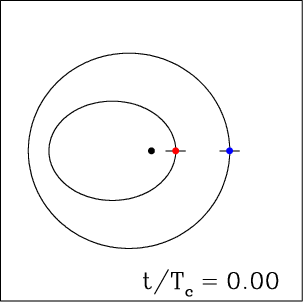
The orbits of the two planets about the star GJ 876 are in a set of resonances, with the orbital periods nearly in the ratio 1:2. The resonances mean that
The following figure show the conjunction configuration, with the black, red, and blue dots representing the star and the inner and outer planets, respectively. The ellipses are the orbits of the planets, with the periapses marked by dashes. (The eccentricities of the orbits shown are larger than the real ones so that the positions of the periapses are more visible.)
Click on the figure to see an animation illustrating the maintenance of the alignment and conjunction configuration as the orbits precess.
The orbits of the inner three Galilean satellites of Jupiter - Io, Europa, and Ganymede - are in a set of resonances, with the orbital periods nearly in the ratios 1:2:4. The resonances mean that
The following figure shows the configuration with Europa and Ganymede in conjunction, with the black, red, green, and blue dots representing Jupiter, Io, Europa, and Ganymede, respectively. The ellipses are the orbits of the satellites, with the periapses marked by dashes. (The eccentricities of the orbits shown are larger than the real ones so that the positions of the periapses are more visible.)
Click on the figure to see an animation illustrating the maintenance of the antialignment of the orbits of Io and Europa and the conjunction configurations as the orbits precess due to the gravitational interactions among the satellites. The animation is slowed down for the first orbit of Ganymede to show the various conjunction configurations.